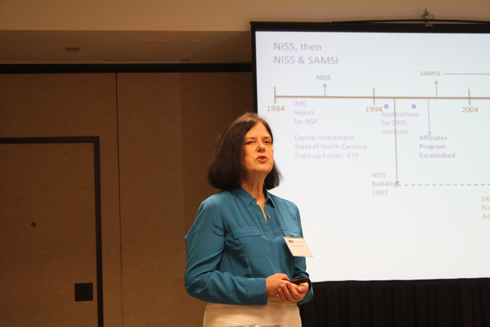The following was written by Lea Jenkins, Associate Professor, Mathematical Sciences Department at Clemson University and one of the program leaders for the SAMSI Mathematical and Statistical Ecology Program.
The workshop combined scientific lectures with hands-on workshop components to inform participants of the current trends in mathematical and statistical computing. The lecture content included material on current modeling efforts for navigational flows, movement and tracking of ecological species (both aquatic and terrestrial), current trends in scientific computing languages and environments, and ecological inference. Hand-on material included information on repository management, computation and documentation using Python and R software, and creation and documentation of tests for software and data validation and verification to ensure scientific replicability of published results. Lightning talks preceded a poster session on the first evening of the workshop. The lightning talks introduced participants to one another and were used to begin collaborative discussions. Scientific lectures were delivered by scientists at the USACE Engineer Research and Development Center (USACE-ERDC), the University of Illnois at Urbana-Champaign (UIUC), the University of North Carolina at Chapel Hill (UNC-CH), and Continuum Analytics. Hands-on lecture content on effective uses of current software tools for simulation and analysis in the science disciplines were delivered by scientists from USACE, SESYNC, the University of Arizona, UIUC, and Continuum Analytics. Breakout sessions were started on Wednesday afternoon.
There were four primary topics for the breakout sessions. One session began an analysis of migration patterns of various species of fish, with data provided by a participant from the World Wildlife Fund. A second session focused on developing computational models from a conceptual framework, and wrote a basic simulation tool incorporating agent-based models with stochastic movement dynamics. A third session worked on issues surrounding data assimilation, where data exists on multiple scales and the different realizations must be combined to deliver an accurate description of the underlying dynamics. The associated problems of interest included finer scale resolution of census data and resolution of remote sensing and direct measurements of bathymetry in near-coastal regions. The fourth session focused on rendering and building distinct finite element structures for use in hydraulic simulation codes. Many of the participants were early career, ranging from graduate students to postdocs to early-career scientists between the postdoc and academic career realms. Github repository accounts were created for each of the breakout groups to allow continue collaborative efforts beyond the end of the workshop.


















